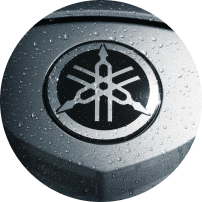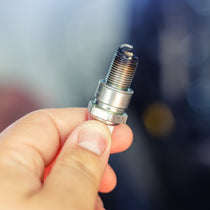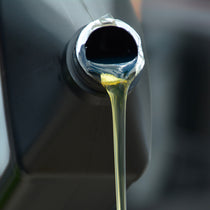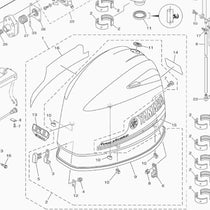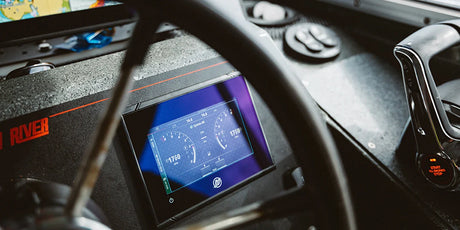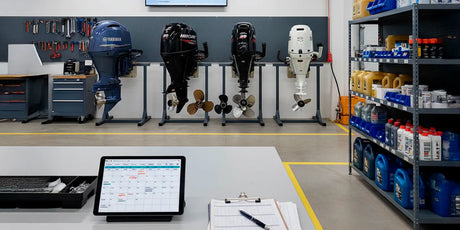Do you believe that your Yamaha outboard head gasket is in bad shape?
Your Yamaha outboard head gasket is a very important component in the performance and lifespan of your engine. Located between the cylinder head (where your spark plugs are screwed in) and the cylinder block, a head gasket is responsible for sealing these components together to withstand the compression from the engine and enable cooling water to flow between the block and the head.
Like most outboard components, parts age through usage and time. Head gaskets that are regularly exposed to excessive heat, corrosive saltwater, and other substances will eventually reduce the integrity of the gasket.
However, if a head gasket is not replaced when it begins to fail, water will begin to enter the engine. Once this happens, the performance of your outboard will be significantly affected and eventually lead to major engine damage.
To avoid this, there are a number of telltale signs to look out for when it’s time to replace your Yamaha outboard head gasket, including:
- Head gasket location on a Yamaha outboard motor
- 2-stroke outboard head gasket symptoms
- Reaching the 4-Year Mark
- Low Pressure in the Cylinders
- Water Coming Out of a Spark Plug Hole
- Black Specks, Crud, and Slime in the Cylinder
- Idle Runs Too Slow or Rough
- Holes In the Head Gasket
Head gasket location on a Yamaha outboard motor
The head gasket location on a Yamaha outboard motor is between the cylinder head and cylinder block. It serves as a seal to contain engine compression and coolant flow.
Steps to locate the head gasket:
- Remove the engine cowling to expose the powerhead.
- Identify the cylinder head—this is where your spark plugs are installed.
- The head gasket is sandwiched between the cylinder head and the engine block, ensuring a tight seal.
A failing head gasket can allow water, fuel, or exhaust gases to leak, leading to performance issues.
2-stroke outboard head gasket symptoms
If your 2-stroke outboard has a blown or failing head gasket, you may notice:
- Overheating Issues – Loss of coolant or water intrusion into the cylinder causes excessive heat.
- Loss of Power – A compromised gasket affects compression levels, reducing engine performance.
- Water in the Cylinder – Check for water exiting the spark plug hole when removing spark plugs.
- Milky or Discolored Oil – Oil contamination suggests coolant leaking into the crankcase.
- Rough Idle or Misfires – Unstable RPMs due to incomplete combustion caused by water leaks.
If you notice these 2-stroke outboard head gasket symptoms, perform a compression test to confirm a blown gasket before it causes more damage.
1. Reaching the 4-Year Mark
To ensure your Yamaha outboard performs its best and to extend its lifespan, preventative maintenance should always be a top priority. Yamaha recommends a number of regular maintenance intervals for your outboard based on its usage - 20 hours for a new engine, every 100 hours or annually, and enhanced service at 300 hours and 500 hours.
The total cost to replace a Yamaha outboard head gasket depends on DIY or professional service. Yamaha recommends replacing it every four years, even if no symptoms are present, to prevent overheating and performance loss. Depending on your usage, this timeframe may be shortened but four years is generally regarded as a “must” to change your head gasket before other problems develop.
There may be no visible signs of head gasket damage by this time, but this repair will give you peace of mind - plus, when you’re changing the head gasket, you can perform other inspections and replacements (such as anodes, engine bores, salt/sand buildup, spark plugs).
2. Low Pressure in the Cylinders
Another common sign that your Yamaha outboard head gasket is in need of repair is low pressure in the cylinders. This requires a simple compression test on each cylinder, which involves removing each spark plug, plugging in a compression gauge, and cranking your engine without giving it throttle (PartsVu’s guide for compression testing).
What you’ll be looking for as you test each cylinder is near-identical readings between cylinders. If there’s more than 10% variance between each cylinder, it’s likely that the head gasket is the culprit.
3. Black Specks, Crud, and Slime in the Cylinder
- Black specks & crud: Combustion byproducts flaking off.
- Gray slime: Water mixing with oil due to a failing gasket.
- Fix: Replace the head gasket immediately to prevent further damage.
4. Idle Runs Too Slow or Rough
When idling, especially at low RPMs, you may notice that your engine runs too slow - almost to the point of completely dying. Or, it may provide a rough idle that’s not consistent, causing a jarring motion.
The reason for these events is that the spark plugs cannot create a consistent spark due to water leakage on the spark plugs. If you remove the spark plugs and notice corrosion, then water is leaking in and diluting the fuel due to a faulty head gasket.
5. Holes In the Head Gasket

If you’ve managed to remove the cylinder head, it’s important to inspect the head gasket itself. The head gasket should not have any holes where it makes contact with the cylinder head and the engine block, as well as the areas around it.
However, this may require cleaning the gasket of any sand or salt that’s penetrated and accumulated around the gasket to get a clear visual of the problem. It’s common when removing this debris to discover that it was intermittently plugging and eating away at the gasket material (and parts of the cylinder), causing an intermittent problem.
Unfortunately, not catching this problem in time can lead to serious repairs to the cylinder head and other affected parts - all of which can be very expensive and require professional work.
Frequently Asked Questions (FAQ) about Head Gaskets
Can you replace a head gasket yourself?
Yes, a head gasket repair is an easy job that only requires a few tools. Unlike a vehicle, where getting to the head gasket requires the removal of the engine and other components, an outboard is smaller and easy to access.
How much does it cost for a new head gasket on a Yamaha outboard?
If you choose to replace your Yamaha outboard head gasket yourself, you can only be on the hook for parts ($50 or less for many engine models) and tools (many of which you may already have in your toolbox).
Taking your outboard to a mechanic will include the cost of parts, but also labor. Considering labor generally costs between $70 - $120 (or more!), the total cost of just a head gasket replacement can be a few hundred dollars. Of course, the advantage of a head gasket replacement by a mechanic is that they can make other replacements, trim the heads if they’re warped, and diagnose any other developing issues that may be plaguing your Yamaha outboard.
To summarize, the total cost to replace a head gasket on a Yamaha outboard motor varies based on whether you perform the repair yourself or hire a mechanic.
DIY replacement cost:
- New head gasket: $30 - $50 (varies by engine model)
- Tools & materials: $10 - $50 (if you don’t already own them)
- Total DIY Cost: $40 - $100
Professional replacement cost:
- New head gasket: $50 or less
- Labor rates: $70 - $120 per hour
- Estimated labor time: 2 - 4 hours
- Total Professional Cost: $200 - $500+
How to Perform a Compression Test for a Yamaha Outboard Head Gasket?
- Remove all spark plugs from the engine.
- Insert a compression gauge into one cylinder at a time.
- Turn the engine over several times without giving throttle.
- Compare readings between cylinders – if one cylinder is significantly lower, the head gasket is likely the issue.
Is a head gasket worth fixing?
Yes—replacing a failing head gasket early can prevent serious engine damage, saving thousands in future repairs. If you have basic mechanical skills, you can replace the gasket yourself and reduce the total cost to replace a head gasket significantly.
The total cost to replace a head gasket varies, but replacing your Yamaha outboard head gasket early prevents overheating and engine failure.
* * *
Now that you understand the most common signs that your Yamaha outboard head gasket may need replacing, it’s time to grab the parts (and some elbow grease) to perform this relatively simple repair. PartsVu has everything you need to replace your Yamaha outboard head gasket and much more, including a full line of T-H Marine boating essentials. Shop for your parts today!
***
This content was designed to serve as a general guide. Persons who are not familiar with marine engine repair and who have not been trained in the recommended servicing or installation procedures should have the work performed by an authorized marine mechanic. Improper installation or servicing of parts can result in engine or boat damage, personal injury to the installer, or harm to persons operating the product.


